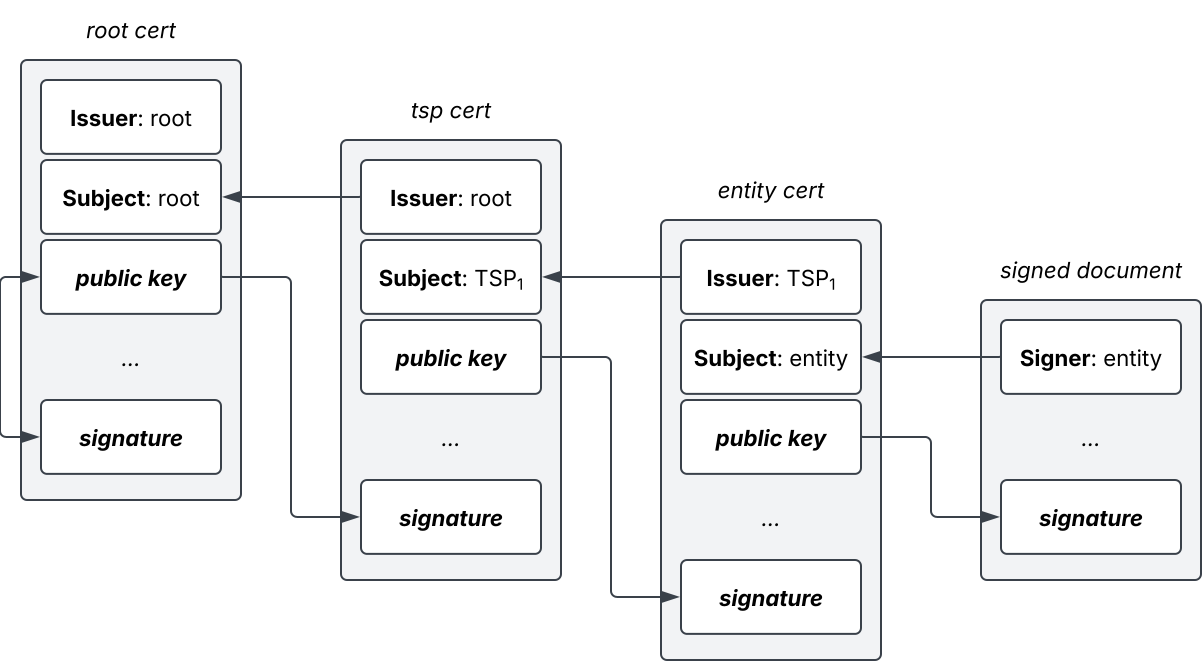X.509 Certificate (CSEC)
The X.509 Certificate is a standardised certificate format and is commonly used by Public Key Infrastructures (PKI) to ensure interoperability between systems.
Structure
X.509 v3 is specified in RFC5280, which defines the certificate's structure as a sequence of three fields tbsCertificate1, signatureAlgorithm, signatureValue.
Notably, signatureValue contains the digital signature over the data in tbsCertificate.
The following information is typically provided by a certificate:
| Field | Description |
|---|---|
| signatureValue | The digital signature of the certificate. |
| Version | The version number of the certificate, e.g. v3 for an X.509 v3 certificate. Different versions support different fields, e.g. the Extensions are only available with v3. |
| Serial Number | The serial number is used to identify a certificate. Certificate Revocation Lists (CRL) use the serial numbers of certificates that are revoked. Also helps with search queries. Issuer and Serial Number uniquely identify a certificate. |
| Signature (in tbsCertificate) | Contains the identifier of the algorithm used by the CA to sign the certificate2. |
| Issuer | Identifies the entity that signed and issued the certificate. The value is a distinguished name following x.501 specifications. |
| Validity | Provides information about the certificate's validity period, i.e. start and end date. |
| Subject | The name of the entity the certificate refers to, i.e. the subject and public key owner (in the same format as Issuer). |
| Subject Public Key Info | The public key of the subject, along with the identifier of the algorithm used with the key. |
| Extensions | Extensions used with the certificate. Provides flags to indicate whether the extension is critical. If an extension is marked as critical and the extension cannot be processed, the validating entity is advised to discard the certificate. Examples of extensions are: - Basic Constraints: Helps with identifying the certificate's subject as a CA - Key Usage: The purpose of the public key contained in the certificate, e.g. signing, encryption etc. |
Roles and Responsibilities
Signing entities and public key holders have responsibilities in certificate management. The following roles are commonly involved:
- Key Generation Authority: Responsible for generating key pairs. May be a dedicated system of the certificate issuer or the chip card of the public key holder, in which case the private key never leaves the secure environment.
- Registration Authority (RA): Handles registration of subjects requesting certificates, and handles validation of data and identities.
- Naming Authority: Ensures that entities are assigned unique and unambiguous names.
- Certification Authority (CA): Issues and maintains certificates and Certificate Revocation Lists (CRLs).
- Directory: Provides directory services that publish certificates and CRLs.
Certification Path
Figure 1 visualizes a certification path from a signed document up to the root-CA.
The root certificate is self signed (as indicated by Basic Constraints: CA).
The CA issues a certificate for TSP, which issues a certificate for entity.
entity signs the document with its private key and publishes its public key via a directory service.
A relying party receiving the document builds the certification path starting with the entity's certificate up to the root CA. The full chain of trust must then be validated to verify the document's signature.
- Starting with the root CA, its public key is used to verify the signature of TSP: Its
signatureValue-field contains the signature of thetbsCertificate-section. - This step repeats with the public key of TSP to verify the entity's
signatureValue. - Only after all certificates were validated, the signature of the document is verified using the entity's public key.
Depending on the context, different validation models apply. RFC5280 specifies the path validation procedures outlined above in full technical detail. Additional requirements for constraints in path validation may be imposed by national laws, regulatory frameworks or institutional policies3.

Example Certificate
Here is an example x.509 certificate as raw OpenSSL data4. It uses RSA as the public key algorithm. The Subject Public Key Info-section includes the public exponent and the modulus.
Certificate:
Data:
Version: 3 (0x2)
Serial Number:
06:43:ce:64:db:c3:68:3f:5b:59:e4:b7:9e:d5:a6:09:f1:b1
Signature Algorithm: sha256WithRSAEncryption
Issuer: C = US, O = Let's Encrypt, CN = R11
Validity
Not Before: Apr 26 19:01:08 2025 GMT
Not After : Jul 25 19:01:07 2025 GMT
Subject: CN = thorsten.suckow-homberg.de
Subject Public Key Info:
Public Key Algorithm: rsaEncryption
RSA Public-Key: (2048 bit)
Modulus:
00:98:98:58:eb:ec:cb:b6:77:81:e8:70:0e:87:22:
31:ef:d2:63:63:67:01:9c:90:4e:10:16:94:9c:f5:
19:b6:05:30:56:b6:82:41:62:d4:31:0b:79:c0:d4:
e1:c1:36:13:1f:5c:70:16:21:d0:1c:53:13:8c:3c:
0c:8c:5d:15:47:f8:c7:94:29:41:8f:c2:e3:b2:29:
b6:1b:77:8d:a8:73:ea:d8:63:91:37:d2:26:50:61:
a1:04:bd:fa:76:22:06:a5:a0:3d:dc:07:4b:8f:b7:
06:24:b6:17:92:2e:c9:ae:dc:16:2c:2c:c3:6c:94:
23:2d:9f:9d:d4:40:da:98:26:3d:67:87:37:b6:4c:
a4:a3:ee:52:31:e3:87:2c:ed:38:ee:70:a5:b5:98:
7d:c3:87:96:fb:2e:45:6c:a2:6c:24:ff:63:42:b6:
e4:7c:d4:5f:6b:96:73:24:7a:0c:a5:89:68:86:f1:
71:03:79:53:0e:88:1c:6e:5a:a5:f0:80:0c:66:0d:
a4:a2:20:b5:b9:09:1c:00:35:8f:3c:89:a7:8a:8c:
4e:57:fd:1e:28:19:3a:63:d0:56:03:e9:f5:32:0d:
37:40:3f:9a:90:71:33:d7:d7:b4:7e:41:48:b4:05:
aa:8e:f7:65:36:87:87:66:ca:ff:6d:83:43:ef:48:
ac:8d
Exponent: 65537 (0x10001)
X509v3 extensions:
X509v3 Key Usage: critical
Digital Signature, Key Encipherment
X509v3 Extended Key Usage:
TLS Web Server Authentication, TLS Web Client Authentication
X509v3 Basic Constraints: critical
CA:FALSE
X509v3 Subject Key Identifier:
58:C9:B2:AA:68:E6:A5:48:CC:D8:2B:E8:42:B2:BF:7F:BE:45:66:68
X509v3 Authority Key Identifier:
keyid:C5:CF:46:A4:EA:F4:C3:C0:7A:6C:95:C4:2D:B0:5E:92:2F:26:E3:B9
Authority Information Access:
OCSP - URI:http://r11.o.lencr.org
CA Issuers - URI:http://r11.i.lencr.org/
X509v3 Subject Alternative Name:
DNS:thorsten.suckow-homberg.de
X509v3 Certificate Policies:
Policy: 2.23.140.1.2.1
X509v3 CRL Distribution Points:
Full Name:
URI:http://r11.c.lencr.org/50.crl
CT Precertificate SCTs:
Signed Certificate Timestamp:
Version : v1 (0x0)
Log ID : 0D:E1:F2:30:2B:D3:0D:C1:40:62:12:09:EA:55:2E:FC:
47:74:7C:B1:D7:E9:30:EF:0E:42:1E:B4:7E:4E:AA:34
Timestamp : Apr 26 19:59:38.393 2025 GMT
Extensions: none
Signature : ecdsa-with-SHA256
30:46:02:21:00:C2:E2:B1:FE:BD:4E:96:B5:D3:26:D2:
E4:18:94:87:2F:30:F9:58:4F:A0:34:61:12:70:15:DA:
69:93:9B:8D:A5:02:21:00:95:44:FB:37:A3:A1:C1:E1:
56:1A:51:E1:01:17:16:7F:A6:FE:64:6D:12:2A:93:09:
F3:DE:58:E2:B0:4F:CA:4E
Signed Certificate Timestamp:
Version : v1 (0x0)
Log ID : AF:18:1A:28:D6:8C:A3:E0:A9:8A:4C:9C:67:AB:09:F8:
BB:BC:22:BA:AE:BC:B1:38:A3:A1:9D:D3:F9:B6:03:0D
Timestamp : Apr 26 19:59:38.624 2025 GMT
Extensions: none
Signature : ecdsa-with-SHA256
30:45:02:20:1E:86:F9:C9:DC:EB:5B:42:60:81:80:4F:
1D:D7:EC:2C:3C:21:B6:FE:D3:61:9B:75:7F:EC:74:A7:
D2:F7:6F:7C:02:21:00:B6:15:AE:CC:DF:4C:47:AF:89:
53:B4:10:8D:81:5B:84:70:F1:2A:55:0D:8D:40:51:E4:
BE:28:B9:FC:66:C3:E2
Signature Algorithm: sha256WithRSAEncryption
0b:23:74:7e:1a:5e:83:a7:84:a3:af:85:d1:70:83:5e:f7:f0:
38:3c:fd:1e:8a:42:4d:cd:6b:ca:88:83:9c:6d:7f:c6:80:92:
51:e8:5a:42:18:b3:b4:c2:ea:df:63:58:28:71:20:29:27:09:
e4:f6:9b:6f:41:4a:32:8d:43:f7:bf:d1:53:25:12:76:17:77:
34:8c:fc:a7:cc:78:2a:14:cc:20:dc:38:7b:cf:a6:b0:bc:4d:
10:bc:a3:59:40:a9:08:4b:81:49:9c:ee:2c:86:3e:65:64:25:
87:4e:0f:6e:05:4f:9d:0e:be:9f:0c:09:d4:36:dc:2f:c3:54:
0c:19:d1:34:06:a9:61:31:64:c9:e5:a7:36:39:f3:70:84:55:
4e:b0:d9:6b:4a:f7:f7:ce:35:f6:f4:14:26:29:b9:64:d1:66:
15:a9:31:73:d1:25:a0:bd:43:68:10:83:4f:a9:9e:4d:b6:11:
8d:1a:cd:4b:49:d0:d8:ea:90:52:e3:c6:d0:9e:50:b1:99:d0:
28:9e:84:9c:47:e7:66:05:18:d4:e8:ea:e2:3c:d3:0b:bd:de:
69:81:6e:2e:25:db:61:9d:bd:f2:77:db:dd:4c:ae:31:14:fe:
ad:01:ec:b1:a4:6b:31:dd:84:c7:f7:05:b1:d4:bf:88:62:5b:
19:4f:de:60
Footnotes
-
tbs = to be signed ↩
-
redundant to signatureAlgorithm, an identifier of the algorithm used to create the signature with the help of the Issuer's private key. ↩
-
for example, BSI Germany describes hybrid and shell validation model: BSI TR-03145-5 Secure CA Operation Version 1.0.1 (retrieved 07.05.2025) ↩
-
retrieved 06.05.2025 from this website, https://thorsten.suckow-homberg.de ↩